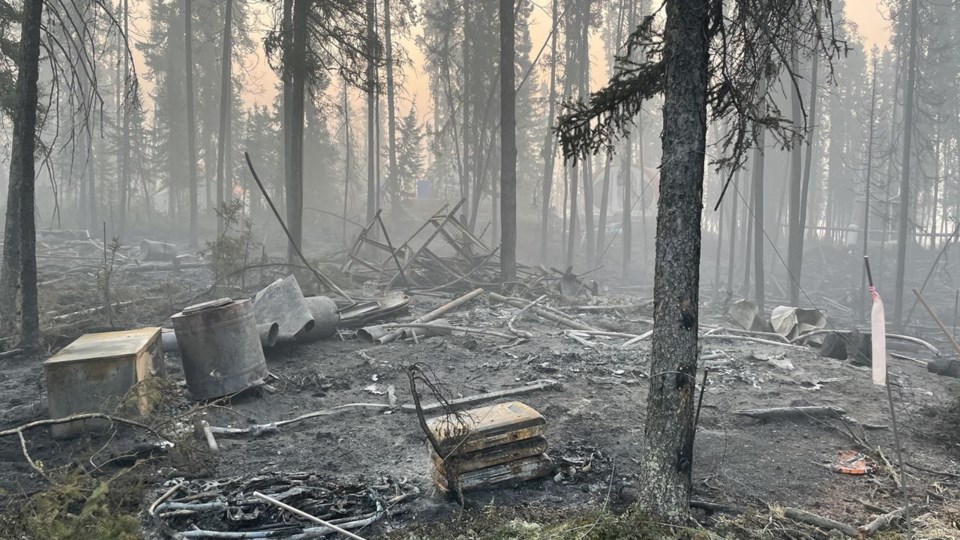FORT SIMPSON, N.W.T. — A wildfire that almost destroyed an Indigenous-led research station in the Northwest Territories is expected to have far-reaching effects on environmental research and the community.
The Liidlii Kue First Nation says five of nine buildings at the Scotty Creek Research Station, roughly 50 kilometres south of Fort Simpson, N.W.T., burned to the ground last weekend destroying equipment, laboratory space and sleeping accommodations. Other buildings sustained varying degrees of damage, with some needing to be replaced.
"It was a gut punch," Dieter Cazon, manager of lands and resources for the First Nation, said on learning of the damage.
"We're not starting from scratch, but we've been set back a long way," said Bill Quinton, director of the research station and a professor of geography and environmental studies at Wilfrid Laurier University.
Scotty Creek is one of the busiest research stations in Canada's North and scientists from across Canada and the world travel there to study environmental factors, such as water resources and permafrost thaw. It also hosts on-the-land camps, high school students and community-focused events and activities.
The First Nation, which has been collaborating with researchers since the 1990s, took over leadership of the station in August, making it one of the first Indigenous-led research stations in the world. Cazon said the facility brings together western science and traditional knowledge to address climate change.
"The Dene monitors and guardians at Liidlii Kue First Nation, they love going out there," he said. "It's a great place to work and participate by learning a little bit more about the land in a different way."
Cazon said they are still assessing the fire damage and making plans to rebuild the camp. For safety reasons, he said they likely won't be able to host any work at the site next year.
"We are going to get this fixed. The work that we're doing is too important to just be kind of kicked around and talked about."
Quinton, who helped start the station in 1989, said at least 20 researchers from various universities use the site and over the years he has started many friendships and collaborations through it. He said it was a welcoming place that is important to elders, youth, and people who spend time on the land.
"There's a lot of people that are really heartbroken," he said. "The loss is devastating — there's no question about that — but at this point we have to look at what we have and what can we make of what we have left to rebuild."
Cazon said there will also be impacts on the community. Researchers travelling to the North bring business to hotels, restaurants and charter airlines.
"I'm sure people will feel the hit a bit when those extra dollars aren't coming into the community next year," he said.
Liidlii Kue First Nation criticized the territory's Department of Environment and Natural Resources for failing to attack the wildfire and removing a sprinkler system while the fire was still active.
Wildfire Information Officer Mike Westwick said sprinklers and other structure protection had successfully protected the site from the first pass of the wildfire, but they were removed last Thursday due to issues with freezing.
He said firefighters could not safely attack the fire directly due to extreme winds, which pushed the fire toward the research station.
"We will never recklessly send staff into harm’s way. And with the fire behaviour in the area, that was what we would be doing if we ordered them to directly attack that fire," he wrote in an email.
"We really do feel for everyone affected by the losses at Scotty Creek."
Westwick said late last week a fire crew and helicopter worked to limit damage, but ice on nearby water bodies made picking up water difficult.
"This is simply a sign of the extraordinary season we’re seeing. When we’re fighting fires and protecting structures, it is highly unusual for there to be the threat of freezing temperatures."
This year's wildfire season has been the most severe the territory has seen since the extremes of 2014, with the total area burned surpassing the 10-year average and nearly tripling the five-year average.
A total of 257 fires have blazed across the territory this year, 30 of which are still active, burning a total of roughly 6,866 square kilometres.
This report by The Canadian Press was first published Oct. 22, 2022.
— by Emily Blake in Yellowknife.
This story was produced with the financial assistance of the Meta and Canadian Press News Fellowship.
The Canadian Press



